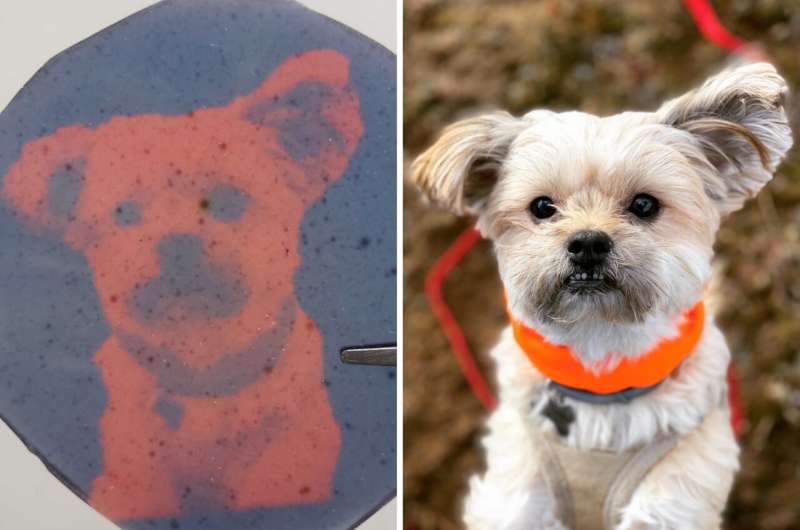
A two-dimensional light engraving (left) suspended in a polymer film. The original photograph (right) was projected into the film using a red and blue light projector, which activates a light-sensitive additive in the polymer. Heating the film erases the image and allows it to be reused. Photo credit: Ivan Aprahamian/Sara Patch
Imagine if doctors could create three-dimensional projections of medical scans and mount them in an acrylic cube to create a handheld reproduction of a patient’s heart, brain, kidneys, or other organs. Once the visit is complete, a quick burst of heat erases the projection and the cube is ready for the next scan.
A report in the magazine Chemistry by researchers at Dartmouth University and Southern Methodist University (SMU) outlines a technical breakthrough that could enable these and other scenarios with far-reaching benefits.
The study presents a technique that uses a special light projector to engrave two- and three-dimensional images into any polymer containing a light-sensitive chemical additive developed by the research group. The light-based engraving remains in the polymer until heat is applied, erasing the image and making it ready for use again.
In short, the researchers write with light and erase with heat or light, says Ivan Aprahamian, professor and chair of chemistry at Dartmouth and co-author of the study. In test experiments, the researchers created high-resolution images in polymers from thin films up to six inches thick.
The technology is intended for any situation where detailed, precise visual data in a compact and easily customizable format can be critical, Aprahamian says, such as planning surgeries and developing architectural designs. The device could also be used to generate 3D images for educational purposes and even to create works of art, he says.
“It’s like 3D printing, only it’s reversible,” says Aprahamian. “You can take any polymer that has optimal optical properties – that is, it’s translucent – and enhance it with our chemical switch. Now that polymer is a 3D display. You don’t need virtual reality headsets or complicated instruments. All you need is the right piece of plastic and our technology.”
Readily available polymers – such as acrylic cubes – could be turned into a display by adding the light-sensitive chemical “switch” developed by Aprahamian and Qingkai Qi, a postdoctoral fellow at Dartmouth and lead author of the study. The switch consists of a compound called azobenzene, which responds to light, paired with boron difluoride, which improves the optical properties of the switch.
Once the switch is incorporated into a polymer, it responds to wavelengths of red and blue light emitted by a projector developed in the lab of Alex Lippert, a professor of chemistry at SMU and co-author of the study. Study co-author Joshua Plank is a graduate student in Lippert’s lab. The red light acts like ink, activating the chemical additive to create the image, Aprahamian says. Blue light can then be used to erase it.
The projector illuminates the treated polymer with different patterns of light from different angles, Lippert explains. The light-sensitive chemical developed in Aprahamian’s lab at Dartmouth is activated where these patterns intersect to create 3D patterns.
Creating 3D projections from 2D images, such as a chest X-ray, would involve projecting sections of the original image into a polymer cube or other shape until the sections coalesce to form a complete 3D image, Lippert said.
The researchers have succeeded in creating animated images in polymers, and future work will focus on improving this process. In the meantime, the technology has been Chemistry In its current form, it could be further developed for practical use, for example in industry or healthcare.
“To increase resolution, the chemical switch properties must be adjusted to improve resolution, contrast and refresh rate,” says Lippert. “The projector system can in principle be scaled up and developed into a turnkey system with automated hardware and associated software for easy operation.”
Further information:
A photoswitchable, wearable volumetric 3D display, Chemistry (2024). DOI: 10.1016/j.chempr.2024.07.012. www.cell.com/chem/fulltext/S2451-9294(24)00355-3
Information about the magazine:
Chemistry
Provided by Dartmouth College
Quote: New technology uses light to engrave erasable 3D images (August 9, 2024), accessed August 9, 2024 from https://phys.org/news/2024-08-technology-engrave-erasable-3d-images.html
This document is subject to copyright. Except for the purposes of private study or research, no part of it may be reproduced without written permission. The contents are for information purposes only.

